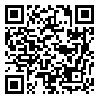دوره 5، شماره 3 - ( 5-1399 )
جلد 5 شماره 3 صفحات 42-37 |
برگشت به فهرست نسخه ها
چکیده: (2222 مشاهده)
Background and Aim: Extraction of teeth in diabetic patients can be followed by some complications such as delay in recovery of hard and soft tissues, dry socket, and increased risk of infection. This study investigated the impact of low-level laser therapy (LLLT) on tooth socket healing following extraction of maxillary molars in male rats.
Materials and Methods: In this experimental study, 30 male rats were divided into control and case groups. All rats were made diabetic with streptozotocin (STZ). After one week, the second molar of all rats was extracted. Helium-Neon (He-Ne) laser from a distance of 5 mm immediately irradiated tooth sockets in the experimental group for 120 seconds, which was continued until the third day. All the rats were sacrificed on days 3, 7, and 14 after the extraction in both groups for pathological evaluation of the amount of granulation tissue, angiogenesis, and the newly formed bone trabeculae, fibroblasts, macrophages, neutrophils, and lymphocytes. The results were statistically analyzed using Kruskal-Wallis test and one-way analysis of variance (ANOVA).
Results: LLLT could increase angiogenesis until day three (P=0.009), reduce the number of lymphocytes after day fourteen (P=0.001), increase the number of fibroblasts and neutrophils (P<0.05), reduce the extent of granulation tissue during the study (P<0.05), and elevate the extent of bone trabeculae after day fourteen (P=0.001).
Conclusion: The results indicated that low-level He-Ne laser therapy could reduce inflammation and accelerate the wound healing process in diabetic rats.
Materials and Methods: In this experimental study, 30 male rats were divided into control and case groups. All rats were made diabetic with streptozotocin (STZ). After one week, the second molar of all rats was extracted. Helium-Neon (He-Ne) laser from a distance of 5 mm immediately irradiated tooth sockets in the experimental group for 120 seconds, which was continued until the third day. All the rats were sacrificed on days 3, 7, and 14 after the extraction in both groups for pathological evaluation of the amount of granulation tissue, angiogenesis, and the newly formed bone trabeculae, fibroblasts, macrophages, neutrophils, and lymphocytes. The results were statistically analyzed using Kruskal-Wallis test and one-way analysis of variance (ANOVA).
Results: LLLT could increase angiogenesis until day three (P=0.009), reduce the number of lymphocytes after day fourteen (P=0.001), increase the number of fibroblasts and neutrophils (P<0.05), reduce the extent of granulation tissue during the study (P<0.05), and elevate the extent of bone trabeculae after day fourteen (P=0.001).
Conclusion: The results indicated that low-level He-Ne laser therapy could reduce inflammation and accelerate the wound healing process in diabetic rats.
نوع مطالعه: Original article |
موضوع مقاله:
Oral & maxillofacial surgery
| بازنشر اطلاعات | |
 |
این مقاله تحت شرایط Creative Commons Attribution-NonCommercial 4.0 International License قابل بازنشر است. |

